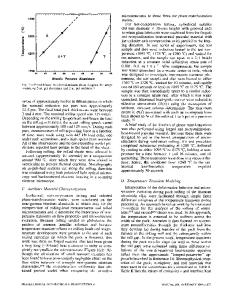Deformation behavior of a Ni 3 Al(B,Zr) alloy during cold rolling: Part II. Microstructural and textural changes
- PDF / 2,869,250 Bytes
- 11 Pages / 612 x 792 pts (letter) Page_size
- 1 Downloads / 363 Views
I. INTRODUCTION
PART I of this series of articles describes the changes in ordering and structure that take place during cold rolling of a Ni3Al(B,Zr) alloy. The long-range order characteristics of this material appear to undergo a change at around 35 pct cold deformation, and this has been interpreted as due to a change in structure from L12 to DO22. Part II of this series of articles describes in detail the microstructural and textural changes that accompany the cold deformation of this material. [1]
II. EXPERIMENTAL The alloy composition; the initial treatments; the cold rolling process; techniques of X-ray measurements; and optical, scanning electron microscopy (SEM), and transmission electron microscopy (TEM) characterization of samples have been given in detail in Part I of this series of articles.[1] Macroscopic texture was determined from the homogenized as well as the different cold-rolled material. For this purpose, 18 3 10-mm rectangular specimens were prepared by carefully polishing rolling plane sections at a depth of one-quarter thickness from any of the free surfaces. From each sample four incomplete pole figures, such as {111}, {200}, {220}, and {311}, were measured in an automatic Xray texture goniometer using Cu Ka radiation.The orientation distribution functions (ODFs) were then computed by means of an iterative series expansion method with lmax 5 22.[2] Taking into consideration the cubic symmetry of the L12 structure of Ni3Al and the orthorhombic symmetry of the flat samples, the ODFs have been represented in the reduced
B. BHATTACHARYA, formerly Postdoctoral Student, Department of Materials and Metallurgical Engineering, Indian Institute of Technology, is Deputy Manager, CRM Complex, Tata Steel, Jamshedpur - 831 001, India. R.K. RAY, Professor, is with the Department of Materials and Metallurgical Engineering, Indian Institute of Technology, Kanpur-208 016, India. Manuscript submitted February 9, 1999. METALLURGICAL AND MATERIALS TRANSACTIONS A
Euler angle (f1, F, f2) space. The f2 sections at 5 deg interval have been plotted in order to give a two-dimensional representation of the texture. III. RESULTS As has already been mentioned,[1] the alloy, in the homogenized condition, has a two-phase microstructure consisting of the g 8 (ordered L12) and g (disordered fcc) phases. The average grain size of the g 8 phase is ,40 to 45 mm, and the g phase, whose volume fraction is about 25 pct, appears as small islands within the g 8 grains. The g islands, in turn, could contain small amounts of fine g 8 particles inside. A. Cold Rolling Microstructures Gradual changes in microstructure were observed when the homogenized alloy was cold rolled at stages up to a maximum level of 73 pct. Significant changes from the homogenized microstructure could be observed even after 25 pct deformation when many of the g islands appeared to be somewhat elongated along the rolling direction (Figure 1(a)). At the same time, these were found to be arranged in parallel rows along possible deformation bands. This trend w
Data Loading...











